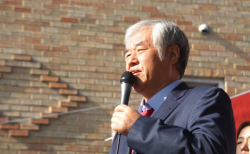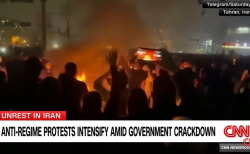본 기고글은 본지의 편집방향과 다를 수 있습니다.
'I am not religious, but I am spiritual'
By Daniel Yoo (Gwinnett School of Mathematics, Science, and Technology)

Q1. “I am not religious, but I am spiritual.” What could the speaker mean by “spiritual”?
Introduction
A de-religious phenomenon among young people is accelerating around the world. The phenomenon has further accelerated during the COVID-19 period(1). The phrase "I am not religious, but I am spiritual" reflects this well. "Spiritual but not religious" (SBNR) is a phrase used in the United States to describe an individual’s spiritual view or to define one’s view of life. Those who pursue this worldview do not regard organized religion as the only or valuable means to promote their spirituality(2). It reveals the tendency of young people who seek religious answers to their life's problems but do not want to belong to organized and systematized religion(3). The rise of the SBNR movement among young people brings a significant shift from organized religion to personalized spirituality, and this trend poses challenges for traditional religious institutions. This essay critically analyzes the rise of SBNR by exploring its meaning, origin, development, and problems and discusses a solution in the context of Christian church.
1. Definition of Religious and Spiritual
In the past, the words “spiritual” and “religious” have been used as the same term. A spiritual person was a religious person, and a religious person was a spiritual person. However, in modern times, these words have different meanings. "Religious" is more associated with the organization of religion, whereas "spiritual" is not related to organized religion. One can be spiritual without being religious. In the other way, one can be religious without being spiritual(4).
For these individuals, spirituality is mainly associated with an individual's inner life(5) and emphasizes the well-being of the "mind-body-spirit."(6) In contrast, religion represents an organizational or communal dimension. Spirituality sometimes signifies a non-institutionalized or individualized form of religiosity. Therefore, the phrase "Spiritual but not religious" can also be expressed as "Spiritual but not affiliated."(7)
2. Origin and Development
The specific expression "Spiritual but not religious" has been used in various academic works, including a 1960 anthropology paper and the biographical paper "Religiousness and Spirituality: Unfuzzying the Fuzzy" by Zinnbauer et al.(8) As a social movement in the United States, the expression “Spiritual, but not religious” was first used by Sven Erlandson as the title of his book in 2000 to describe the religious phenomena that are taking place in the United States.(9) The following year, in 2001, Robert C. Fuller academically elaborated on it in his book “Spiritual, but not Religious: Understanding Unchurched America,” bringing further attention to the concept.(10) The arguments of these two authors suggest that American religious individuals, particularly Christians, have begun to satisfy their spiritual desire outside of institutional churches, and the phenomenon is captured more by the word “spiritual” rather than “religious.”
Therefore, contemporary people understand the term “spirituality” as emphasizing the individual realm outside of institutions or communities, rather than the communal meaning associated with churches. In other words, if religion is associated with doctrines and traditions, traditional thoughts of community, and institutions, then spirituality that values the individual is related to personal experience. The phenomenon has already deeply infiltrated our daily lives, taking various forms such as “mindfulness, meditation, yoga, prayer, tarot card readings, viewing art” of spirituality.(11) The phenomenon of SBNR may have begun to emerge because of the new Romanticism movement that started in the 1960s. The Romanticism movement, with its tendency to support mystical, unorthodox, and exotic approaches, is similar to spiritual movements.(12)
According to a 2023 study by the Pew Research Center, 21% of adult Americans who identify as “spiritual but not religious” are ages 18 to 29, and 37% are between 30 and 49,(13) compared to 15% in 2012, the number among young people continues to grow every year.(14) A separate study released in January found religious membership of young Americans was lower than other demographics – 29% of Americans who have no religious affiliation are 18 to 29, compared to just 13% of all adults over 65. Only 18% of Americans under 30 attend church weekly, according to a recent study, compared to 33% of Americans 65 or older. The same study found young people are also the least likely to read sacred texts or donate money to religious organizations.(15) Young people tended to be more spiritual than religious.
Due to secularization, the public influence of an established religion is decreasing, and as religion becomes more individualized, the form of gatherings is also changing from institutionalized groups to individualized spirituality.(16) The COVID-19 period has further accelerated the trend.
The expression "spiritual but not religious" can be seen as a movement born out of great disappointment with Christian hypocrites of traditional churches and a desire not to feel oppressed. Young people perceive religion as a major source of conflict and division in society even though Christians preach peace and love. In addition, Christian doctrine is seen as a tool to oppress and manipulate people.(17) From this perspective, our tasks and alternatives become clear. Young people request that the church restore its public nature and church-likeness.
However, some argue that the phenomenon of leaving the church is not solely due to ethical disappointment with the church. The other reason is due to the secularization effect, which has reduced the public role and domain of religion to the private and personal realm, leading to changes in the role and perception of religion among modern individuals. Finally, young generation leave the church to meet a personal need for mystical experiences that traditional churches can no longer provide.(18) The SBNR-style spirituality emerging to fulfill the need is replacing religion.
3. Problems
According to Carlson, the problem with SBNR mindset is “making my faith my own.” The attitude allows a person to do whatever he wants, which includes unaffiliated Christians, nature-worshipers, agnostics and other unbelievers who seek the transcendent in psychedelic drugs, and even committed atheists like philosopher Sam Harris, many of whom define spirituality as merely “living more contemplatively.” In essence, “I’m spiritual but not religious” means whatever a person wants it to mean.(19) To create mystical experiences artificially, the use of drugs or brain stimulation can cause many physical, ethical, and social problems.
Secondly, selfish spirituality leads into complacency and self-centeredness.
They reveal the inclination of young Americans who seek religious answers to their life's problems but do not want to belong to organized and systematized religions. The spirituality that pursuits "free from any religious doctrines and norms leads people into inherent risks that their own standard" carries.(20) Father James Martin stated that spirituality without religion can become a self-centered complacency divorced from the wisdom of a community. Furthermore, he points out it would be difficult for a god tells such a person to share his goods or wealth with the poor and love his enemies.(21)
Conclusion
The spirituality used by pastors and theologians in the church might be understood in entirely different contexts and meanings compared to the spirituality used by lay people. One of the many crises the church faces today is that the content of Christian faith and belief, doctrine and faith knowledge, worship, and traditions of life are not deeply connected with the individual's mystical experiences of the believers, resulting in their separation. The task for the modern church is to find a way to restore true Christian spirituality that is not secularized or individualized but integrates the public and private realms and combines mystery and rationality.
Second, the reason SBNR avoids organized religion is because the church has lost its spirituality. In other words, this is because young people can no longer have a mystical experience of spirituality in church. Therefore, to prevent the departure of young people, the church has to bring balance between religion and spirituality, the church should be able to draw out the inner religious sense of future generations through self-reflection and contemplation through spiritual or devout training. They must provide various opportunities for young people to meet the mystical experience of spirituality by baptism, the Lord's Supper, and worship services that traditional churches already had.
Third, the church needs to practice holiness. True spirituality will protect the church from corruption. All spiritualities presuppose some doctrine which provides their ethical foundation. These doctrines are usually passed down as part of a tradition which requires a community. All spiritualities also involve some practices aimed at bringing about an inner transformation. They are again passed down and practiced communally. These sorts of changes would mark a transition from the merely spiritual to the religious.(22) Holiness must be restored in the church through training true spirituality. God said, “Be holy, for I am holy.” Restoration of holiness is also God's command for the church.
Finally, the church must restore a loving community. Is it possible to separate religion and spirituality? The answer is No. All spirituality stems from the communal aspect of religion. All religions emphasize individual salvation, but they also accentuate loving each other. Spirituality does not mean growing and communing with God alone. It is based on having a positive influence on many others and loving each other. Just as religion is meaningless without love for each other, spirituality without a loving community is also meaningless.
References
(1) Jeanet S. Bentzen, “In Crisis, We Pray: Religiosity and the Covid-19 Pandemic,” CEPR Discussion Paper DP14824, https://www.ncbi.nlm.nih.gov/pmc/articles/PMC8557987/ (accessed May 4, 2024).
(2) Daniel A. Cox, “Turning Against Organized Religion,” Survey Center on American Life, https://www.americansurveycenter.org/newsletter/turning-against-organized-religion/ (accessed May 4, 2024).
(3) Christian Daily, “Young Americans are spiritual but not religious,” https://kr.christianitydaily.com/ articles/40393/20100612/(accessed May 15, 2024)
(4) Camel 2, “Spiritual or Religious? What is the Difference?” The Ohio State University Press, https://u.osu.edu/studentwellnesscenter/2023/03/24/spiritual-or-religious-what-is-the-difference/#:~:text=Spirituality%20and%20religion%20are%20often,still%20consist%20of%20different%20concepts (accessed May 15, 2024).
(5) Jeremy R. Carrette and Richard King, Selling Spirituality: The Silent Takeover of Religion,
(London, UK: Routledge, 2004), 41.
(6) Paul Heelas, Spiritualities of Life: New Age Romanticism and Consumptive Capitalism, (Wiley Blackwell: 2009), 63.
(7) Joseph Blankholm, The Secular Paradox : On the Religiosity of the Not Religious, (New York: New York University Press: 2022), 7.
(8) Brian J. Zinnbauer, Kenneth I. Pargament, and Brenda Cole, “Religiousness and Spirituality: Unfuzzying the Fuzzy,” Journal for the Scientific Study of Religion 36 (December 1997): 549–564.
(9) Sven E. Erlandson, Spiritual but Not Religious: A Call to Religious Revolution in America (Bloomington: Universe, 2000), 17.
(10) Robert C. Fuller, Spiritual, but not Religious: Understanding Unchurched America (Oxford: Oxford University Press, 2001), 2-4.
(11) Liz Bucar, “As Spirituality Rises, Many Young People Are Redefining and Rethinking Religion,” TeenVogue, https://www.teenvogue.com/story/spirituality-rises-young-people-religion#:~:text=According%20to%20a%20study%20Pew,are%20between%2030%20and%2049 (accessed May 22, 2024)
(12) Owen Thomas, Owen (January 2006). “Spiritual but Not Religious: The Influence of the Current Romantic Movement”. Anglican Theological Review 88:3 (January 2006): 397.
(13) Bucar, “As Spirituality Rises, Many Young People Are Redefining and Rethinking Religion,”
(14) Cary Funk and Greg Smith, “"Nones" on the Rise: One-in-Five Adults Have No Religious Affiliation,” (PDF). The Pew Forum on Religion and Public Life, https://www.kzoo.edu/news /religious-nones-on-the-rise-in-u-s-reports-pew-center-researcher-and-thompson-lecturer-at-kalamazoo-college/#:~:text=The%20Pew%20Research% 20Center%20finds,Adults%20 Have %20No%20Religious%20Affiliation (accessed May 29, 2024).
(15) Bucar, “As Spirituality Rises, Many Young People Are Redefining and Rethinking Religion,”
(16) Lindsey Witt-Swanson, Jennifer Benz, and Daniel A. Cox, “Faith After the Pandemic: How Covid-19 Changed American Religion,” The 2022 American Religious Benchmark Survey,” https://www.americansurveycenter.org/research/faith-after-the-pandemic-how-covid-19-changed-american-religion/ (accessed May 30, 2024)
(17) Carlson B., “Addressing the Spiritual but Not Religious Movement: The Catholic Response to SBNR,” Introspection and Apologetics, https://catholicismcoffee.org/addressing-the-spiritual-but-not-religious-movement-catholicismcoffee-80cba55d1db9 (accessed May 30, 2024)
(18) Ibid.
(19) Ibid.
(20) Martin, James (2010-03-11). "Spiritual but not religious - Not so fast!: Making the case for moving beyond your own personal God". Busted Halo, https://bustedhalo.com/features/spiritual-but-not-religious-not-so-fast (accessed May 31, 2024).
(21) Ibid.
(22) Jeremiah Carey, “Spiritual, but not religious?: On the nature of spirituality and its relation to religion,” Springer 10 (October 2017): 9.


































































